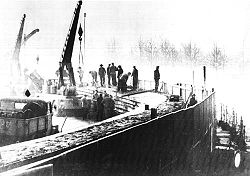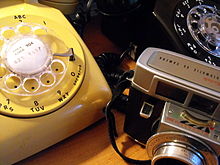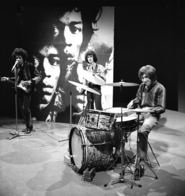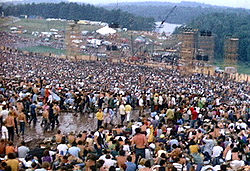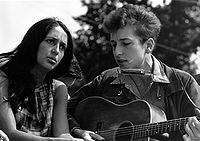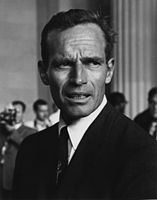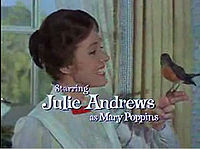- 1960s
-
"'60s" redirects here. For decades comprising years 60–69 of other centuries, see List of decades.
 From left, clockwise: A soldier lays on the ground during the Vietnam War; The Beatles, part of the British Invasion, change music in America and around the world; John F. Kennedy is assassinated in 1963, after serving the office of president for three years; Martin Luther King Jr. makes his famous I Have a Dream Speech to a crowd of over a million; Millions participate in the Woodstock Festival of 1969; China's Mao Zedong puts forward the Great Leap Forward plan; The bombing of the Mount of Olives during the Six-Day War; For the first time in history, an American human being sets his foot on the Moon, in the Moon landing of July 1969.
From left, clockwise: A soldier lays on the ground during the Vietnam War; The Beatles, part of the British Invasion, change music in America and around the world; John F. Kennedy is assassinated in 1963, after serving the office of president for three years; Martin Luther King Jr. makes his famous I Have a Dream Speech to a crowd of over a million; Millions participate in the Woodstock Festival of 1969; China's Mao Zedong puts forward the Great Leap Forward plan; The bombing of the Mount of Olives during the Six-Day War; For the first time in history, an American human being sets his foot on the Moon, in the Moon landing of July 1969.
Millennium: 2nd millennium Centuries: 19th century – 20th century – 21st century Decades: 1930s 1940s 1950s – 1960s – 1970s 1980s 1990s Years: 1960 1961 1962 1963 1964 1965 1966 1967 1968 1969 Categories: Births – Deaths – Architecture
Establishments – DisestablishmentsThe 1960s was the decade that started on January 1, 1960, and ended on December 31, 1969.[1] It was the seventh decade of the 20th century.
The 1960s term also refers to an era more often called The Sixties, denoting the complex of inter-related cultural and political trends across the globe. This "cultural decade" is more loosely defined than the actual decade, beginning around 1963 and ending around 1974.[2][3]
In the United States, "the Sixties", as they are known in popular culture, is a term used by historians, journalists, and other objective academics; in some cases nostalgically to describe the counterculture and social revolution near the end of the decade; and pejoratively to describe the era as one of irresponsible excess and flamboyance. The decade was also labeled the Swinging Sixties because of the fall or relaxation of some social taboos especially relating to sexism and racism that occurred during this time.
The 1960s have become synonymous with the new, radical, and subversive events and trends of the period, which continued to develop in the 1970s, 1980s, 1990s and beyond. In Africa the 1960s was a period of radical political change as 32 countries gained independence from their European colonial rulers.
Some commentators[4] have seen in this era a classical Jungian nightmare cycle, where a rigid culture, unable to contain the demands for greater individual freedom, broke free of the social constraints of the previous age through extreme deviation from the norm. Christopher Booker charts the rise, success, fall/nightmare and explosion in the London scene of the 1960s. This does not alone however explain the mass nature of the phenomenon.
Several governments turned to the left in the early 1960s. In the United States, John F. Kennedy, a Keynesian[5] and staunch anti-communist who pushed for centre-left social reforms such as civil rights for African Americans and healthcare for the elderly and the poor, was elected to the Presidency; he also pledged to land a man on the Moon by the end of the decade, a feat that was accomplished in 1969. Italy formed its first left-of-centre government in March 1962 with a coalition of Christian Democrats, Social Democrats, and moderate Republicans. Socialists joined the ruling block in December 1963. In Britain, the Labour Party gained power in 1964.[6] In Brazil, João Goulart became president after Jânio Quadros resigned.
Contents
Politics and wars
Wars
- The Cold War:
- The Vietnam War (1955–1975)
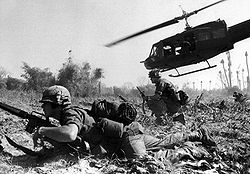 Vietnam War (1955–1975)
Vietnam War (1955–1975)
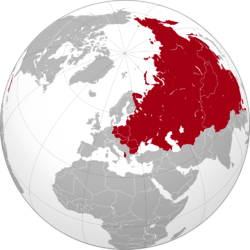 The maximum territorial extent of countries in the world under Soviet influence, after the Cuban Revolution of 1959 and before the official Sino-Soviet split of 1961
The maximum territorial extent of countries in the world under Soviet influence, after the Cuban Revolution of 1959 and before the official Sino-Soviet split of 1961
-
-
- 1961 – Substantial (approximately 700) American advisory forces first arrive in Vietnam in 1961.
- 1962 – By mid-1962, the number of U.S. military advisers in South Vietnam had risen from 700 to 12,000.
- 1963 – After the overthrow of the Diem Regime in early November 1963, Kennedy increased the number of U.S. military advisers from 800 to more than 16,000 to cope with rising guerrilla activity in Vietnam.
- 1964 – After the Gulf of Tonkin incident, on August 2, 1964, and the Gulf of Tonkin Resolution which was a joint resolution of the U.S. Congress passed on August 10, 1964, in direct response to a minor naval engagement known as the Gulf of Tonkin Incident. The resolution gave U.S. President Lyndon B. Johnson authorization, without a formal declaration of war by Congress, for the use of military force in Southeast Asia. The Johnson administration subsequently cited the resolution as legal authority for its rapid escalation of U.S. military involvement in the Vietnam War.[7]
- 1966 – After 1966 with the draft in place more than 500,000 troops are sent to Vietnam by the Johnson administration and college attendance soars.
- The Bay of Pigs Invasion (1961) – an unsuccessful attempt by a CIA-trained force of Cuban exiles to invade southern Cuba with support from US government armed forces, to overthrow the Cuban government of Fidel Castro.
- Portuguese Colonial War (1961–1974) – the war was fought between Portugal's military and the emerging nationalist movements in Portugal's African colonies. It was a decisive ideological struggle and armed conflict of the cold war in African (Portuguese Africa and surrounding nations) and European (mainland Portugal) scenarios. Unlike other European nations, the Portuguese regime did not leave its African colonies, or the overseas provinces, during the 1950s and 1960s. During the 1960s, various armed independence movements, most prominently led by communist-led parties who cooperated under the CONCP umbrella and pro US groups, became active in these areas, most notably in Angola, Mozambique, and Portuguese Guinea. During the war, several atrocities were committed by all forces involved in the conflict.
-
- Arab–Israeli conflict (early 20th century-present)
- Six Days War (June 1967) – a war between Israel and the neighboring states of Egypt, Jordan, and Syria. The Arab states of Iraq, Saudi Arabia, Sudan, Tunisia, Morocco and Algeria also contributed troops and arms.[8] At the war's end, Israel had gained control of the Sinai Peninsula, the Gaza Strip, the West Bank, East Jerusalem, and the Golan Heights. The results of the war affect the geopolitics of the region to this day.
- The Algerian War came to a close in 1962.
- The Nigeria Civil War begins in 1967.
Internal conflicts
- Cultural Revolution in China (1966–1976) – a period of widespread social and political upheaval in the People’s Republic of China which was launched by Mao Zedong, the chairman of the Communist Party of China. Mao alleged that "liberal bourgeois" elements were permeating the party and society at large and that they wanted to restore capitalism. Mao insisted that these elements be removed through post-revolutionary class struggle by mobilizing the thoughts and actions of China's youth, who formed Red Guards groups around the country. The movement subsequently spread into the military, urban workers, and the party leadership itself. Although Mao himself officially declared the Cultural Revolution to have ended in 1969, the power struggles and political instability between 1969 and the arrest of the Gang of Four in 1976 are now also widely regarded as part of the Revolution.
- The Troubles in Northern Ireland began with the rise of the Civil Rights movement in the mid 60s, the conflict continued into the later 90s.
- The Compton's Cafeteria Riot occurred in August 1966 in the Tenderloin district of San Francisco. This incident was one of the first recorded transgender riots in United States history, preceding the more famous 1969 Stonewall Riots in New York City by three years.
- The Stonewall riots occurred in June 1969 in the New York City. The Stonewall riots were a series of spontaneous, violent demonstrations against a police raid that took place in the Stonewall Inn, in the Greenwich Village neighborhood of New York City. They are frequently cited as the first instance in American history when people in the homosexual community fought back against a government-sponsored system that persecuted sexual minorities, and they have become the defining event that marked the start of the gay rights movement in the United States and around the world.
- The May 1968 student and worker uprisings in France.
- Mass socialist or Communist movement in most European countries (particularly France and Italy), with which the student-based new left was able to forge a connection. The most spectacular manifestation of this was the May student revolt of 1968 in Paris that linked up with a general strike of ten million workers called by the trade unions; and for a few days seemed capable of overthrowing the government of Charles de Gaulle. De Gaulle went off to visit French troops in Germany to check on their loyalty. Major concessions were won for trade union rights, higher minimum wages and better working conditions.
- University students protested in their hundreds of thousands in London, Paris, Berlin and Rome with the huge crowds that protested against the Vietnam War.
- In Eastern Europe students also drew inspiration from the protests in the West. In Poland and Yugoslavia they protested against restrictions on free speech by communist regimes.
- The Tlatelolco massacre – was a government massacre of student and civilian protesters and bystanders that took place during the afternoon and night of October 2, 1968, in the Plaza de las Tres Culturas in the Tlatelolco section of Mexico City.
Coups
Main article: List of coups d'état and coup attempts#1960–1969The most prominent coups d'état of the decade include:
- On April 21, 1967 in Greece a group of colonels established a military dictatorship for seven years.
- In 1968 a coup in Iraq led to the overthrow of Abdul Rahman Arif by the Arab Socialist Baath Party.
- On September 1, 1969, a small group of military officers led by the army officer Muammar al-Gaddafi overthrows monarchy in Libya.
Nuclear threats
- The Cuban Missile Crisis (October 1962) – a near military confrontation between the U.S. and the Soviet Union about the presence of Soviet missiles in Cuba. After an American Naval (quarantine) blockade of Cuba the Soviet Union under the leadership of Nikita Khrushchev agreed to remove their missiles in exchange the US would remove its missiles from Turkey.
- On October 16, 1964 China detonated its first atomic bomb. China possessed a hydrogen bomb by 1967. President Johnson secretly considered a preemptive strike on China's nuclear facilities, but then dismissed the idea as too risky.[citation needed]
Decolonization and independence
- The transformation of Africa from colonialism to independence in what is known as the decolonisation of Africa dramatically accelerated during the decade, with 32 countries gaining independence between 1960 and 1968. Marking the end of the great European empires that once dominated the African continent, However The noble aspirations of these new nations quickly faded, and many states descended into anarchy, kleptocracy, dictatorships, and/or civil war. The road to prosperity has been difficult: As of 2011[update], by many measures Africa continues to possess the poorest population[9] in the world as well as the lowest life expectancy.
Prominent political events
 Martin Luther King Jr.'s "I Have a Dream" speech in Washington, D.C., August 28, 1963
Martin Luther King Jr.'s "I Have a Dream" speech in Washington, D.C., August 28, 1963
United States
- 1960 – United States presidential election, 1960 – The key turning point of the campaign was the series of four Kennedy-Nixon debates; they were the first presidential debates held on television.
- 1961 – Newly elected President John F. Kennedy and Vice President Lyndon B. Johnson take office in 1961; Kennedy establishes the Peace Corps.
- 1963 – Martin Luther King Jr.'s "I Have a Dream" speech in Washington, D.C. on August 28.
- 1963 – President Lyndon Johnson becomes president and presses for civil rights legislation.
- 1964 – U.S. President Lyndon B. Johnson is elected in his own right, defeating United States Senator Barry Goldwater in November.
- 1964 – Civil Rights Act of 1964 signed into law by President Lyndon B. Johnson. This landmark piece of legislation in the United States outlawed racial segregation in schools, public places, and employment.
- 1964 – Wilderness Act signed into law by President Lyndon B. Johnson on September 3.
- 1965 – U.S. President Lyndon B. Johnson and Vice President Hubert H. Humphrey take office in January.
- 1965 – National Voting Rights Act of 1965 signed into law by President Lyndon B. Johnson. Outlawed discriminatory voting practices that had been responsible for the widespread disenfranchisement of African Americans in the United States.
- 1968 – U.S. President Richard M. Nixon is elected defeating Vice President Hubert H. Humphrey in November.
- 1969 – U.S. President Richard Nixon is inaugurated in January 1969; promises "peace with honor" to end the Vietnam War.
Canada
- The Quiet Revolution in Quebec altered the province into a more secular society. The Jean Lesage Liberal government created a welfare state (État-Providence) and fomented the rise of active nationalism among Francophone Québécois.
- On February 15, 1965, the new maple leaf flag was adopted in Canada, after much acrimonious debate known as the Great Flag Debate.
- In 1960, the Canadian Bill of Rights becomes law, and Universal suffrage, the right for any Canadian citizen to vote, is finally adopted by John Diefenbaker's Progressive Conservative government. The new election act allows first nations people to vote for the first time.
Europe
- Construction of the Berlin Wall started in 1961.
- British Prime Minister Harold Macmillan delivers his Wind of Change speech in 1960.
- Pope John XXIII calls the Second Vatican Council of the Catholic Church, continued by Pope Paul VI, which met from October 11, 1962, until December 8, 1965.
- In October 1964, Soviet leader Nikita Khrushchev was expelled from office due to his increasingly erratic and authoritarian behavior. Leonid Brezhnev and Alexei Kosygin then became the new leaders of the Soviet Union.
- In Czechoslovakia 1968 was the year of Alexander Dubček’s Prague Spring, a source of inspiration to many Western leftists who admired Dubček's "socialism with a human face". The Soviet invasion of Czechoslovakia in August ended these hopes and also fatally damaged the chances of the orthodox communist parties drawing many recruits from the student protest movement.
China
- Relations with the United States remained hostile during the 1960s, although representatives from both countries held periodic meetings in Warsaw, Poland (since there was no US embassy in China). President Kennedy had plans to restore Sino-US relations, but his assassination, the war in Vietnam, and the Cultural Revolution put an end to that. Not until Richard Nixon took office in 1969 was there another opportunity.
- Following Soviet leader Nikita Khrushchev's expulsion in 1964, Sino-Soviet relations devolved into open hostility. The Chinese were deeply disturbed by the Soviet suppression of the Prague Spring in 1968, as the latter now claimed the right to intervene in any country it saw as deviating from the correct path of socialism. Finally, in March 1969, armed clashes took place along the Sino-Soviet border in Manchuria. This drove the Chinese to restore relations with the US, as Mao Zedong decided that the Soviet Union was a much greater threat.
Mexico
- The peak of the student and New Left protests in 1968 coincided with political upheavals in a number of other countries. Although these events often sprung from completely different causes, they were influenced by reports and images of what was happening in the United States and France.
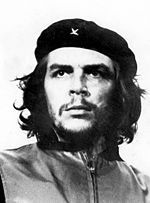 By the late 1960s, revolutionary Che Guevara's famous image had become a popular symbol of rebellion for many youth.
By the late 1960s, revolutionary Che Guevara's famous image had become a popular symbol of rebellion for many youth.
Middle East
- On September 1, 1969, the Libyan monarchy was overthrown, and a radical, anti-Israel, anti-Western government headed by Col. Muammar al-Qadaffi took power.
South America
- In 1964, a successful coup against the democratically elected government of Brazilian president João Goulart, initiates a military dictatorship of over 20 years of oppression.
- The Argentine revolutionary Ernesto "Che" Guevara travelled to Africa and then Bolivia in his campaigning to spread worldwide revolution. He was captured and executed in 1967 by the Bolivian army, and afterwards became an iconic figure for leftists around the world.
- Juan Velasco Alvarado took power in Peru in 1968.
India
- In India a literary and cultural movement started in Calcutta, Patna, and other cities by a group of writers and painters who called themselves "Hungryalists", or members of the Hungry generation. The band of writers wanted to change virtually everything and were arrested with several cases filed against them on various charges. They ultimately won these cases. This span of the movement was from 1961 to 1964.
Assassinations
 John F. Kennedy assassination – President Kennedy with his wife, Jacqueline, and Texas Governor John Connally in the presidential limousine, minutes before his assassination.
John F. Kennedy assassination – President Kennedy with his wife, Jacqueline, and Texas Governor John Connally in the presidential limousine, minutes before his assassination.
The 1960s were marked by several notable assassinations:
- January 17, 1961 – Patrice Lumumba, the Prime Minister of the Republic of the Congo. Assassinated by a Belgian and Congolese firing squad outside Lubumbashi, Democratic Republic of the Congo.
- May 27, 1963 - Grigoris Lambrakis, Greek left-wing MP by far-right extremists with connections to the police and the army in Thessaloniki.
- June 12, 1963 – Medgar Evers, an NAACP field secretary. Assassinated by a member of the Ku Klux Klan in Jackson, Mississippi.
- November 2, 1963 – Ngo Dinh Diem, President of Vietnam, along with his brother and chief political adviser, Ngo Dinh Nhu. Assassinated by Duong Hieu Nghia and Nguyen Van Nhung in the back of an armoured personnel carrier.
- November 22, 1963 – John F. Kennedy, President of the United States. The accused was Lee Harvey Oswald, according to the 1964 report issued by the Warren Commission, in his car during a parade in Dallas, Texas from gunshot wound. See JFK assassination for more details.
- February 21, 1965 – Malcolm X. Assassinated by members of the Nation of Islam in New York City. There is a dispute about which members killed Malcolm X.
- September 6, 1966 – Hendrik Verwoerd, Prime Minister of South Africa and architect of apartheid was stabbed to death by Dimitri Tsafendas, a parliamentary messenger. He survived a previous attempt on his life in 1960.
- August 25, 1967 – George Lincoln Rockwell, leader of the American Nazi Party. Assassinated by John Patler in Arlington, Virginia.
- April 4, 1968 – Martin Luther King, Jr., civil rights leader. Assassinated by James Earl Ray in Memphis, Tennessee.
- June 5, 1968 – Robert F. Kennedy, United States Senator. Assassinated by Sirhan Sirhan in Los Angeles, California, taking California in the presidential national primaries.
Disasters
- 1960 Valdivia earthquake or Great Chilean Earthquake is to date the most powerful earthquake ever recorded, rating 9.5 on the moment magnitude scale. It caused localized tsunamis that severely battered the Chilean coast, with waves up to 25 meters (82 ft). The main tsunami raced across the Pacific Ocean and devastated Hilo, Hawai'i.
- 1969 – Cuyahoga River catches fire in Ohio. Fires had erupted on the river many times, including June 22, 1969, when a river fire captured the attention of Time magazine, which described the Cuyahoga as the river that "oozes rather than flows" and in which a person "does not drown but decays." Helped spur legislative action on water pollution control resulting in the Clean Water Act, Great Lakes Water Quality Agreement, and the creation of the federal Environmental Protection Agency.
- 1969 – Hurricane Camille hits the Gulf Coast at Category 5 Status on the night of August 17. To date it is the strongest hurricane ever recorded at landfall in means of sustained windspeed in the Atlantic Basin, reaching sustained winds of 190 mph and a low pressure of 905 mbs. It is one of only three hurricanes in the Atlantic to ever make landfall at Category 5 Status and one of only four hurricanes worldwide to reach a maximum sustained windspeed of 190 mph.
Science and technology
Science
Space exploration
The Space Race between the United States and the Soviet Union would dominate the 1960s. The Soviets sent the first man, Yuri Gagarin, into outer space during the Vostok 1 mission on 12 April 1961 and scored a host of other successes, but by the middle of the decade the US was taking the lead. In May 1961, President Kennedy set for the United States the goal of a manned spacecraft landing on the Moon by the end of the decade.
In 1966 the Soviet Union launched Luna 10, which later becomes the first space probe to enter orbit around the Moon.
The tragic deaths of astronauts Gus Grissom, Edward Higgins White, and Roger B. Chaffee in the Apollo 1 fire on 27 January 1967 put a temporary hold on the US space program, but afterwards progress was steady, with the Apollo 8 crew (Frank Borman, Jim Lovell, William Anders) being the first manned mission to orbit another celestial body (the moon) during Christmas of 1968.
On July 20, 1969, Apollo 11, the first human spaceflight landed on the Moon. Launched on July 16, 1969, it carried Mission Commander Neil Armstrong, Command Module Pilot Michael Collins, and Lunar Module Pilot Buzz Aldrin. Apollo 11 fulfilled President John F. Kennedy's goal of reaching the moon by the end of the 1960s, which he had expressed during a speech given before a joint session of Congress on May 25, 1961: "I believe that this nation should commit itself to achieving the goal, before this decade is out, of landing a man on the Moon and returning him safely to the Earth."
The Soviet program lost its sense of direction with the death of chief designer Sergey Korolyov in 1966. Political pressure, conflicts between different design bureaus, and engineering problems caused by an inadequate budget would doom the Soviet attempt to land men on the moon.
A succession of unmanned American and Soviet probes travelled to the Moon, Venus, and Mars during the 1960s, and commercial satellites also came into use.
Other scientific developments
- 1960 – The female birth control contraceptive, the pill, was released in the United States after Food and Drug Administration (FDA) approval.
- 1967 – First heart transplantation operation by Professor Christiaan Barnard in South Africa.
Technology
Automobiles
As the 1960s began, American cars showed a rapid rejection of 1950s styling excess, and would remain relatively clean and boxy for the entire decade. The horsepower race reached its climax in the late 1960s, with muscle cars sold by most makes. The compact Ford Mustang, launched in 1964, was one of the decade's greatest successes. The "Big Three" American automakers enjoyed their highest ever sales and profitability in the 1960s, but the demise of Studebaker in 1966 left American Motors Corporation as the last significant independent. The decade would see the car market split into different size classes for the first time, and model lineups now included compact and mid-sized cars in addition to full-sized ones.
Electronics and communications
- 1960 – The first working laser was demonstrated in May by Theodore Maiman at Hughes Research Laboratories.
- 1962 – First trans-Atlantic satellite broadcast via the Telstar satellite.
- 1962 – The first computer video game, Spacewar!, is invented.
- 1963 – The first geosynchronous communications satellite, Syncom 2 is launched.
- 1963 – First trans-Pacific satellite broadcast via the Relay 1 satellite.
- 1963 – Touch-Tone telephones introduced.
- 1963 - Sketchpad was the first touch interacted computer graphics program.
- 1963 – Video recorder The Nottingham Electronic Valve company produces the first home video recorder called the "Telcan".
- 1964 – The first successful Minicomputer, Digital Equipment Corporation’s 12-bit PDP-8, is marketed.
- 1964 – The programming language BASIC was created.
- 1967 – PAL and SECAM broadcast color TV systems start publicly transmitting in Europe.
- 1967 – The first Automatic Teller Machine is opened in Barclays Bank, London.
- 1968 – The first public demonstration of the computer mouse, the paper paradigm Graphical user interface, video conferencing, teleconferencing, email, and hypertext.
- 1969 – Arpanet, the research-oriented prototype of the Internet, was introduced.
- 1969 – CCD invented at AT&T Bell Labs, used as the electronic imager in still and video cameras.
Social and political movements
Counterculture/social revolution
See also: Counterculture of the 1960s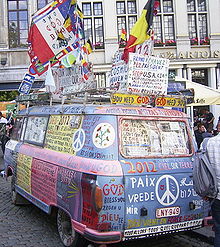 Flower Power Bus
Flower Power Bus
In the second half of the decade, young people began to revolt against the conservative norms of the time, as well as remove themselves from mainstream liberalism, in particular the high level of materialism which was so common during the era. This created a "counterculture" that sparked a social revolution throughout much of the western world. It began in the United States as a reaction against the conservatism and social conformity of the 1950s, and the US government's extensive military intervention in Vietnam. The youth involved in the popular social aspects of the movement became known as hippies. These groups created a movement toward liberation in society, including the sexual revolution, questioning authority and government, and demanding more freedoms and rights for women and minorities. The Underground Press, a widespread, eclectic collection of newspapers served as a unifying medium for the counterculture. The movement was also marked by the first widespread, socially accepted drug use (including LSD and marijuana) and psychedelic music.
Anti-war movement
Main article: Opposition to the U.S. involvement in the Vietnam WarThe war in Vietnam would eventually lead to a commitment of over half a million American troops, resulting in over 58,500 American deaths and producing a large-scale antiwar movement in the United States. As late as the end of 1965, few Americans protested the American involvement in Vietnam, but as the war dragged on and the body count continued to climb, civil unrest escalated. Students became a powerful and disruptive force and university campuses sparked a national debate over the war. As the movement's ideals spread beyond college campuses, doubts about the war also began to appear within the administration itself. A mass movement began rising in opposition to the Vietnam War, ending in the massive Moratorium protests in 1969, as well as the movement of resistance to conscription ("the Draft") for the war.[citation needed]
The antiwar movement was initially based on the older 1950s Peace movement, heavily influenced by the American Communist Party, but by the mid-1960s it outgrew this and became a broad-based mass movement centered in universities and churches: one kind of protest was called a "sit-in". Other terms heard in the United States included "the Draft", "draft dodger", "conscientious objector", and "Vietnam vet". Voter age-limits were challenged by the phrase: "If you're old enough to die for your country, you're old enough to vote." Many of the youth involved in the politics of the movements distanced themselves from the "hippies".[citation needed]
The rise of feminism
Main article: FeminismFeminism in the United States and around the world gained momentum in the early 1960s. At the time, a woman's place was generally seen as being in the home, and they were excluded from many jobs and professions. Commercials often portrayed a woman as being helpless if her car broke down. In the US, a Presidential Commission on the Status of Women found discrimination against women in the workplace and every other aspect of life, a revelation which launched two decades of prominent women-centered legal reforms (i.e. the Equal Pay Act of 1963, Title IX, etc.) which broke down the last remaining legal barriers to women's personal freedom and professional success. Feminists took to the streets, marching and protesting, writing books and debating to change social and political views that limited women. In 1963, with Betty Friedan's revolutionary book, The Feminine Mystique, the role of women in society, and in public and private life was questioned. By 1966, the movement was beginning to grow in size and power as women's group spread across the country and Friedan, along with other feminists, founded the National Organization for Women. In 1968, "Women's Liberation" became a household term as, for the first time, the new women's movement eclipsed the black civil rights movement when New York Radical Women, led by Robin Morgan, protested the annual Miss America pageant in Atlantic City, New Jersey. The movement continued throughout the next decades.
Gay rights movement
Main articles: Gay Liberation and LGBT social movementsThe United States, in the middle of a social revolution, led the world in LGBT rights in the late 60s and early 70s. Inspired by the civil rights movement and the women's movement, early gay rights pioneers had begun, by the 1960s, to build a movement. These groups were rather conservative in their practices, emphasizing that gays were just like straights and deserved full equality. This philosophy would be dominant again after AIDS, but by the very end of the 1960s, the movement's goals would change and become more radical, demanding a right to be different, and encouraging gay pride.
The symbolic birth of the gay rights movement would not come until the decade had almost come to a close. Gays were not allowed by law to congregate together. Gay establishments such as the Stonewall Inn in New York City were routinely raided by the police to arrest gay people. On a night in late June 1969, LGBT people resisted, for the first time, a police raid, and rebelled openly in the streets. This uprising called the Stonewall Riots began a new period of the LGBT rights movement that in the next decade would cause dramatic change both inside the LGBT community and in the mainstream American culture.
Hispanic and Chicano Movement
Another large ethnic minority group, the Mexican-Americans, are among other Hispanics in the U.S. who fought to end racial discrimination and socioeconomic disparity. The largest Mexican-American populations was in the Southwestern United States, such as California with over 1 million Chicanos in Los Angeles alone, and Texas where Jim Crow laws included Mexican-Americans as "non-white" in some instances to be legally segregated.
Socially, the Chicano Movement addressed what it perceived to be negative ethnic stereotypes of Mexicans in mass media and the American consciousness. It did so through the creation of works of literary and visual art that validated Mexican-American ethnicity and culture. Chicanos fought to end social stigmas such as the usage of the Spanish language and advocated official bilingualism in federal and state governments.
The Chicano Movement also addressed discrimination in public and private institutions. Early in the twentieth century, Mexican Americans formed organizations to protect themselves from discrimination. One of those organizations, the League of United Latin American Citizens, was formed in 1929 and remains active today.[10]
The movement gained momentum after World War II when groups such as the American G.I. Forum, which was formed by returning Mexican American veterans, joined in the efforts by other civil rights organizations.[11]
Mexican-American civil rights activists achieved several major legal victories including the 1947 Mendez v. Westminster Supreme Court ruling which declared that segregating children of "Mexican and Latin descent" was unconstitutional and the 1954 Hernandez v. Texas ruling which declared that Mexican Americans and other racial groups in the United States were entitled to equal protection under the 14th Amendment of the U.S. Constitution.[12][13]
The most prominent civil rights organization in the Mexican-American community is the Mexican American Legal Defense and Educational Fund (MALDEF), founded in 1968.[14] Although modeled after the NAACP Legal Defense and Educational Fund, MALDEF has also taken on many of the functions of other organizations, including political advocacy and training of local leaders.
Meanwhile, Puerto Ricans in the U.S. mainland fought against racism, police brutality and socioeconomic problems affecting the three million Puerto Ricans residing in 50 states, the main concentration was in New York City. They formed political action groups, became further involved in city and national politics, and became proud of their heritage, in spite of stereotypes and being viewed as "foreign" despite Puerto Rico is US territory.
In the 1960s and the following 1970s, Hispanic-American culture was on the rebound like ethnic music, foods, culture and identity both became popular and assimilated into the American mainstream. Spanish-language television networks, radio stations and newspapers increased in presence across the country, especially in US-Mexican border towns and East Coast cities like New York City, and the growth of the Cuban American community in Miami, Florida.
The multitude of discrimination at this time represented an inhuman side to a society that in the 1960s was upheld as a world and industry leader. The issues of civil rights and warfare became major points of reflection of virtue and democracy, what once was viewed as traditional and inconsequential was now becoming the significance in the turning point of a culture. A document known as the Port Huron Statement exemplifies these two conditions perfectly in its first hand depiction, “while these and other problems either directly oppressed us or rankled our consciences and became our own subjective concerns, we began to see complicated and disturbing paradoxes in our surrounding America. The declaration "all men are created equal..." rang hollow before the facts of Negro life in the South and the big cities of the North. The proclaimed peaceful intentions of the United States contradicted its economic and military investments in the Cold War status quo.” These intolerable issues became too visible to ignore therefore its repercussions were feared greatly, the realization that we as individuals take the responsibility for encounter and resolution in our lives issues was an emerging idealism of the 1960s.
African-American Civil Rights Movement 1955-1968
see African-American Civil Rights Movement
New Left
The rapid rise of a "New Left" applied the class perspective of Marxism to postwar America, but had little organizational connection with older Marxist organizations such as the Communist Party, and even went as far as to reject organized labor as the basis of a unified left-wing movement. The New Left differed from the traditional left in its resistance to dogma and its emphasis on personal as well as societal change. Students for a Democratic Society (SDS) became the organizational focus of the New Left and was the prime mover behind the opposition to the War in Vietnam. The 1960s left also consisted of ephemeral campus-based Trotskyist, Maoist and anarchist groups, some of which by the end of the 1960s had turned to militancy.
Crime
The 1960s has also been associated with a large increase in crime and urban unrest of all types. Between 1960 and 1969 reported incidences of violent crime per 100,000 people in the United States nearly doubled and have yet to return to the levels of the early 1960s.[15] Large riots broke out in many cities, such as Chicago, Detroit, Los Angeles, New York City, Newark, Washington, DC and Oakland. By the end of the decade, politicians such as Richard Nixon and George Wallace campaigned on restoring law and order to a nation troubled with the new unrest.
Additional notable world-wide events
- Manson Murders – took place on August 8–10 1969 which was the death of Sharon Tate, Abigail Folger, along with several others in the Tate house. Killed on August 9, Rosemary LaBianca & Leno LaBianca.
- Canada celebrated its 100th anniversary of Confederation in 1967 by hosting Expo 67, the World's Fair, in Montreal, Quebec. During the anniversary celebrations, French president Charles De Gaulle visited Canada, and caused a considerable uproar by declaring his support for Québécois independence.
Popular culture
The counterculture movement dominated the second half of the 1960s, its most famous moments being the Summer of Love in San Francisco in 1967, and the Woodstock Festival in upstate New York in 1969. Psychedelic drugs, especially LSD, were widely used medicinally, spiritually and recreationally throughout the late 1960s, and were popularized by Timothy Leary with his slogan "Turn on, tune in, drop out". Ken Kesey and the Merry Pranksters also played a part in the role of "turning heads on". Psychedelic influenced the music, artwork and films of the decade, and a number of prominent musicians died of drug overdoses (see 27 Club). There was a growing interest in Eastern religions and philosophy, and many attempts were made to found communes, which varied from supporting free love to religious puritanism.
Music
See also: 1960s in music"The 60′s were a leap in human consciousness. Mahatma Gandhi, Malcolm X, Martin Luther King, Che Guevara, Mother Teresa, they led a revolution of conscience. The Beatles, The Doors, Jimi Hendrix created revolution and evolution themes. The music was like Dalí, with many colors and revolutionary ways. The youth of today must go there to find themselves."
Popular music entered an era of "all hits", as numerous artists released recordings, beginning in the 1950s, as 45-rpm "singles" (with another on the flip side), and radio stations tended to play only the most popular of the wide variety of records being made. Also, bands tended to record only the best of their songs as a chance to become a hit record. The taste of the American listeners expanded from the folksinger, doo-wop and saxophone sounds of the 1950s to the Motown sound, folk rock and the British Invasion. The Los Angeles and San Francisco Sound began in this period with many popular bands coming out of LA and the Haight-Ashbury district, well known for its hippie culture. The rise of the counterculture movement, particularly among the youth, created a market for rock, soul, pop, reggae and blues music.
Significant events in music in the 1960s:
- Elvis Presley returns to civilian life in the USA after two years away in the U.S. Army. He resumes his musical career by recording "It's Now or Never" and "Are You Lonesome Tonight?" in March 1960.[17]
- Motown Record Corporation founded in 1960. Its first Top Ten hit was "Shop Around" by the Miracles in 1960. "Shop Around" peaked at number-two on the Billboard Hot 100, and was Motown's first million-selling record.
- Folksinger and activist Joan Baez released her debut album on Vanguard Records in December 1960.
- The Marvelettes scored Motown Record Corporation's first US #1 pop hit, "Please Mr. Postman" in 1961. Motown would score 110 Billboard Top-Ten hits during its run.
- The Four Seasons released three straight number one hits
- In a widely anticipated and publicized event, The Beatles arrive in America in February 1964, spearheading the British Invasion.
- The Mary Poppins Original Soundtrack tops record charts. Sherman Brothers receive Grammys and double Oscars.
- Lesley Gore: At age 17 hits Number one on Billboard with "It's My Party" and '64 with Number 2 "You Don't Own Me" behind the Beatles "I Wanna Hold Your Hand."
- The Supremes scored twelve number one hit singles between 1964 and 1969, beginning with "Where Did Our Love Go".
- The Kinks release "You Really Got Me" in late 1964, which tops the British charts; it is regarded as the first hard rock hit and a blueprint for related genres, such as heavy metal.[18]
- John Coltrane releases A Love Supreme in late 1964, considered among the most acclaimed jazz albums of the era.
- The Grateful Dead was formed in 1965 (originally The Warlocks) thus paving the way, giving birth to Acid rock.
- Bob Dylan goes electric at the 1965 Newport Folk Festival.
- Cilla Black's number one hit "Anyone who had a Heart" still remains the top selling single by a female artist in the UK from 1964.
- The Rolling Stones have a huge #1 hit with their song "(I Can't Get No) Satisfaction" in the summer of 1965.
- The Byrds release a cover of Bob Dylan's "Mr. Tambourine Man", which reached #1 on the U.S. charts and repeated the feat in the U.K. shortly thereafter. The extremely influential track effectively creates the musical subgenre of folk rock.
- Bob Dylan's "Like a Rolling Stone" is a top-five hit on both sides of the Atlantic during the summer of 1965.
- Bob Dylan's 1965 albums Bringing It All Back Home and Highway 61 Revisited usher in album focused rock and the "folk rock" genre.
- Simon and Garfunkel release The Sound of Silence single in 1965.
- The Beach Boys release Pet Sounds in 1966, which significantly influenced the Beatles Sgt. Pepper album a year later.
- Bob Dylan is called "Judas" by an audience member during the legendary Manchester Free Trade Hall concert, the start of the Bootleg recording industry follows, with recordings of this concert circulating for 30 years – wrongly labeled as – The Royal Albert Hall Concert before a legitimate release in 1998 as The Bootleg Series Vol. 4: Bob Dylan Live 1966, The "Royal Albert Hall" Concert.
- In February 1966, Nancy Sinatra's song "These Boots Are Made for Walkin'" became very popular.
- In 1966, The Supremes A' Go-Go was the first album by a female group to reach the top position of the Billboard magazine pop albums chart in the United States.
- The Seekers are the first Australian Group to have a number one with "Georgy Girl" in 1966.
- Jefferson Airplane released the influential Surrealistic Pillow in 1967.
- The Velvet Underground release their influential self-titled debut album The Velvet Underground & Nico in 1967.
- The Doors release their self-titled debut album The Doors' in January 1967'.
- Love release Forever Changes in 1967.
- The Jimi Hendrix Experience release two successful albums during 1967 Are You Experienced and Axis: Bold as Love that innovate both guitar, trio and recording techniques.
- The Beatles released Sgt. Pepper's Lonely Hearts Club Band in June 1967.
- The Moody Blues release the album Days of Future Passed in November 1967.
- R & B legend Otis Redding has his first No. 1 hit with the legendary Sitting on the Dock of the Bay. He also played at the Monterey Pop Festival in 1967 just before he died in a plane crash.
- Pink Floyd releases their debut record The Piper at the Gates of Dawn.
- Bob Dylan releases the Country rock album John Wesley Harding in December 1967.
- The Bee Gees release their international debut album Bee Gees 1st in July 1967 which contains the pop standard "To Love Somebody".
- The Monterey Pop Festival in 1967 was the beginning of the so-called "Summer of Love".
- Johnny Cash releases At Folsom Prison in 1968
- 1968: after The Yardbirds fold, Led Zeppelin is formed by Jimmy Page and manager Peter Grant, with Robert Plant, John Bonham and John Paul Jones; and, released their debut album Led Zeppelin.
- The Band releases the roots rock album Music from Big Pink in 1968.
- Big Brother and the Holding Company, with Janis Joplin as lead singer, becomes an overnight sensation after their performance at Monterey Pop in 1967 and release their massively successful second album Cheap Thrills in 1968.
- Gram Parsons with The Byrds releases the extremely influential LP Sweetheart of the Rodeo in late 1968, forming the basis for country rock.
- The Jimi Hendrix Experience release the highly influential double LP Electric Ladyland in 1968 that furthered the guitar and studio innovations of his previous two albums.
- Simon and Garfunkel release the single Mrs. Robinson in 1968 featured in the film The Graduate.
Woodstock Festival, 1969
- Sly & the Family Stone revolutionize black music with their massive 1968 hit single "Dance to the Music" and by 1969 became international sensations with the release of their hit record Stand!. The band cemented their position as a vital counterculture band when they performed at the Woodstock Festival.
- The Rolling Stones film the TV special The Rolling Stones Rock and Roll Circus in December 1968 but the film is not released for transmission. Considered for decades as a fabled 'lost' performance until released in North America on Laserdisc and VHS in 1996. Features performances from The Who; The Dirty Mac featuring John Lennon, Eric Clapton and Mitch Mitchell; Jethro Tull and Taj Mahal.
- The Woodstock Festival, and four months later, the Altamont Free Concert in 1969.
- The Who release and tour the first rock opera Tommy in 1969.
- Proto-punk band MC5 release the live album Kick Out The Jams in 1969.
- Captain Beefheart and his Magic Band release the avant garde Trout Mask Replica in 1969.
- The Stooges release their debut album in 1969.
- The Flying Burrito Brothers released their influential debut The Gilded Palace of Sin in 1969.
- King Crimson released their debut album In the Court of the Crimson King in 1969.
Film
See also: History of film#1960s and 1960s in filmThe highest-grossing film of the decade was 20th Century Fox's The Sound of Music.[19]
Some of Hollywood's most notable blockbuster films of the 1960s include: Psycho, Breakfast at Tiffany's, Spartacus, Lawrence of Arabia, The Hustler, Carnival of Souls; The Birds, The Pink Panther, Dr. Strangelove or: How I Learned to Stop Worrying and Love the Bomb; Mary Poppins, The Sound of Music; Doctor Zhivago, The Jungle Book, The Dirty Dozen, Butch Cassidy and the Sundance Kid; Bonnie and Clyde; Cool Hand Luke; The Graduate; Rosemary's Baby; Midnight Cowboy; Head; Medium Cool; 2001: A Space Odyssey; Faces; Night of the Living Dead; Easy Rider; Ice Station Zebra; Planet of the Apes; The Lion In Winter; The Wild Bunch.
The counterculture movement had a significant effect on cinema. Movies began to break social taboos such as sex and violence causing both controversy and fascination. They turned increasingly dramatic, unbalanced, and hectic as the cultural revolution was starting. This was the beginning of the New Hollywood era that dominated the next decade in theatres and revolutionized the film industry. Films of this time also focused on the changes happening in the world. Dennis Hopper's Easy Rider (1969) focused on the drug culture of the time. Movies also became more sexually explicit, such as Roger Vadim's Barbarella (1968) as the counterculture progressed.
In Europe, Art Cinema gains wider distribution and sees movements like la Nouvelle Vague (The French New Wave) featuring French filmmakers such as Roger Vadim, François Truffaut, Alain Resnais, and Jean-Luc Godard; Cinéma Vérité documentary movement in Canada, France and the United States; Swedish filmmaker Ingmar Bergman, Chilean filmmaker Alexandro Jodorowsky and Polish filmmakers Roman Polanski and Wojciech Jerzy Has produced original and offbeat masterpieces and the high-point of Italian filmmaking with Michelangelo Antonioni and Federico Fellini making some of their most known films during this period. Notable films from this period include: La Dolce Vita, 8½; La Notte; L'Eclisse, The Red Desert; Blowup; Satyricon; Accattone; The Gospel According to St. Matthew; Theorem; Winter Light; The Silence; Persona; Shame; A Passion; Au Hasard Balthazar; Mouchette; Last Year at Marienbad; Chronique d'un été; Titicut Follies; High School; Salesman; La jetée; Warrendale; Knife in the Water; Repulsion; The Saragossa Manuscript; El Topo; A Hard Day's Night; and the cinema verite Dont Look Back.
In Japan, a color version remake of director Kenji Mizoguchi's The 47 Ronin, entitled Chushingura: Hana no Maki, Yuki no Maki directed by Hiroshi Inagaki was released in 1962, the legendary story was also remade as a television series in Japan. Academy Award winning Japanese director Akira Kurosawa produced Yojimbo (1961), and Sanjuro (1962), which both starred Toshirō Mifune as a mysterious Samurai swordsman for hire. Like his previous films both had a profound influence around the world. The Spaghetti Western genre was a direct outgrowth of the Kurosawa films. The influence of these films is most apparent in Sergio Leone's A Fistful of Dollars (1964) starring Clint Eastwood and Walter Hill's Last Man Standing (1996). Yojimbo was also the origin of the "Man with No Name" trend which included Sergio Leone's For a Few Dollars More, and The Good, The Bad and The Ugly both also starring Clint Eastwood, and arguably continued through his 1968 opus Once Upon a Time in the West, starring Henry Fonda, Charles Bronson, Claudia Cardinale, and Jason Robards. The Magnificent Seven a 1960 American western film directed by John Sturges was a remake of Akira Kurosawa's 1954 film, Seven Samurai.
The 1960s were also about experimentation. With the explosion of light-weight and affordable cameras, the underground avant-garde film movement thrived. Canada's Michael Snow, Americans Kenneth Anger. Stan Brakhage, Andy Warhol, and Jack Smith. Notable films in this genre are: Dog Star Man; Scorpio Rising; Wavelength; Chelsea Girls; Blow Job; Vinyl; Flaming Creatures.
Significant events in the film industry in the 1960s:
- Removal of the Motion Picture Association of America's Production Code in 1967.
- The decline and end of the Studio System.
- The rise of 'art house' films and theaters.
- The end of the classical hollywood cinema era.
- The beginning of the New Hollywood Era due to the counterculture.
- The rise of independent producers that worked outside of the Studio System.
- Move to all-color production in Hollywood films.
- The invention of the Nagra 1/4", sync-sound, portable open-reel tape deck.
- Expo 67 where new film formats like Imax were invented and new ways of displaying film were tested.
- Flat-bed film editing tables appear, like the Steenbeck, they eventually replace the Moviola editing platform.
- The French New Wave.
- Direct Cinema and Cinéma vérité documentaries.
- The decline and end of The Looney Tunes and Merrie Melodies .
Television
Main article: 1960s in television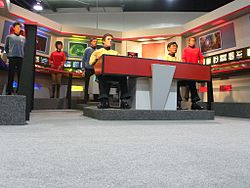 Star Trek: The Original Series (1966–1969)
Star Trek: The Original Series (1966–1969)
The most prominent American TV series of the 1960s include: The Ed Sullivan Show, Peyton Place, Star Trek, I Dream of Jeannie, The Twilight Zone, The Outer Limits, The Andy Williams Show, The Dean Martin Show, The Wonderful World of Disney, Alfred Hitchcock Presents, The Beverly Hillbillies, Bonanza, McHale's Navy, Laugh-In, The Dick Van Dyke Show, The Fugitive, The Tonight Show, Gunsmoke, Mission: Impossible, The Flintstones, The Adventures of Ozzie and Harriet, Lassie, The Danny Thomas Show, The Lucy Show, My Three Sons, The Red Skelton Show and Bewitched. The Flintstones was a favoured show, receiving 40 million views an episode with an average of 3 views a day. Some programming such as The Smothers Brothers Comedy Hour became controversial by challenging the very foundations of America's corporate and governmental controls; making fun of world leaders, and questioning U.S. involvement in and escalation of The Vietnam War.
In the UK, Doctor Who appeared on TV for the first time on 23 November 1963. The series has entered the Guinness book of world records as the longest-running television show to date.
Walt Disney, owner of Walt Disney Co. died on December 15, 1966 from a major tumor in his left lung.
Fashion
Main article: 1960s in fashionSignificant fashion trends of the 1960s include:
- The Beatles exerted an enormous influence on young men's fashions and hairstyles in the 1960s which included most notably the mop-top haircut, the Beatle boots and the Nehru jacket.
- The hippie movement late in the decade also had a strong influence on clothing styles, including bell-bottom jeans, tie-dye and batik fabrics, as well as paisley prints.
- The bikini finally came into fashion in 1963 after being featured in the film Beach Party.
- Mary Quant invented the mini-skirt which became the rage in the late 1960s.
- Men's mainstream hairstyles ranged from the pompadour, the crew cut, the flattop hairstyle, the tapered hairstyle, and short, parted hair in the early part of the decade to longer parted hairstyles with sideburns towards the latter half of the decade.
- Women's mainstream hairstyles ranged from beehive hairdos, the bird's nest hairstyle, and the chignon hairstyle in the early part of the decade to very short styles popularized by Twiggy and Mia Farrow in Rosemary's Baby towards the latter half of the decade.
- African-American hairstyles for men and women included the afro.
Sports
Olympics
There were six Olympic Games held during the decade. These were:
- 1960 XVII Summer Olympics—Rome, Italy
- 1960 VIII Winter Olympics—Squaw Valley Ski Resort, United States
- 1964 XVIII Summer Olympics—Tokyo, Japan
- 1964 IX Winter Olympics—Innsbruck, Austria
- 1968 XIX Summer Olympics—Mexico City, Mexico
- 1968 X Winter Olympics—Grenoble, France
Association football
There were two FIFA World Cups during the decade:
- 1962 FIFA World Cup — hosted in Chile, won by Brazil
- 1966 FIFA World Cup — hosted and won by England
Baseball
Major League Baseball expansion in 1961 included the formation of the Los Angeles Angels, the move to Minnesota to become the Minnesota Twins by the former Washington Senators and the formation of a new franchise called the Washington Senators. Major League Baseball sanctioned both the Houston Colt .45s and the New York Mets as new National League franchises in 1962.
In 1969, the American League expanded when the Kansas City Royals and Seattle Pilots, were admitted to the league prompting the expansion of the post-season for the first time since the creation of the World Series. The Pilots stayed just one season in Seattle before moving and becoming the Milwaukee Brewers in 1970. The National League also added two teams in 1969, the Montreal Expos and San Diego Padres. By 1969, at the end of the 1960s the New York Mets won the World Series in only the 8th year of the team's existence.
Racing
In motorsports, the Can-Am and Trans-Am series were both established in 1966. The Ford GT40 won outright in the 24 Hours of Le Mans. Graham Hill edged out Jackie Stewart and Denny Hulme for the World Championship in Formula One.
People
World leaders
Political figures
- Konrad Adenauer
- Ella Baker
- Leonid Brezhnev
- Stokely Carmichael
- Fidel Castro
- César Chávez
- Sir Winston Churchill
- Park Chung-Hee
- Ramsey Clark
- Moshe Dayan
- Abba Eban
- Charles de Gaulle
- Barry Goldwater
- Andrei Gromyko
- Che Guevara
- Deniz Gezmiş
- Chiang Kai-shek
- David Ben-Gurion
- Averell Harriman
- Tom Hayden
- Abbie Hoffman
- J. Edgar Hoover
- Hubert Humphrey
- Lyndon Baines Johnson
- Edward M. Kennedy
- John F. Kennedy
- Robert F. Kennedy
- Martin Luther King Jr.
- Nikita S. Khrushchev
- John Lindsay
- Ferdinand Marcos
- Harold Macmillan
- Eugene McCarthy
- Robert McNamara
- Golda Meir
- Robert Menzies
- Ho Chi Minh
- Robin Morgan
- Gamal Abdel Nasser
- Huey P. Newton
- Richard M. Nixon
- Lester B. Pearson
- Ronald Reagan
- Jackie Robinson
- Nelson A. Rockefeller
- George Romney
- Eleanor Roosevelt
- Dean Rusk
- Eisaku Sato
- Mario Savio
- Bobby Seale
- Margaret Chase Smith
- Soong Ching-ling
- Gloria Steinem
- Adlai Stevenson II
- Suharto
- U Thant
- Pierre Elliot Trudeau
- George Wallace
- Earl Warren
- Harold Wilson
- Malcolm X
- Mao Zedong
Activists
Musicians
-
John Lennon rehearsing Give Peace A Chance, in Canada, 1969
-
Johnny Cash, in front of his home in Hendersonville, Tennessee, 1969
Entertainers
-
Marlon Brando at the 1963 Civil Rights March on Washington, D.C.
-
Julie Andrews from the trailer for the film "Mary Poppins", 1964
Film makers
Intellectuals
- Richard Alpert aka Baba Ram Dass
- Louis Althusser
- Roland Barthes
- Simone de Beauvoir
- William F. Buckley
- Truman Capote
- Rachel Carson
- Noam Chomsky
- Jacques Derrida
- Michel Foucault
Writers
Visual artists, painters and sculptors
Sports figures
Boxing
- Muhammad Ali
- Cus D'Amato (trainer)
- Angelo Dundee (trainer)
- Duilio Loi
- Antonio Roldán
- Eddie Futch (trainer)
See also
- 1960s in music
- 1960s in fashion
- 1960s in television
- 1960s in literature
- The Sixties Unplugged (book)
Timeline
The following articles contain brief timelines which list the most prominent events of the decade:
1960 • 1961 • 1962 • 1963 • 1964 • 1965 • 1966 • 1967 • 1968 • 1969
References
- ^ Joshua Zeitz "1964: The Year the Sixties Began," American Heritage, Oct. 2006.
- ^ John Barth (1984) intro to The Literature of Exhaustion, in The Friday Book.
- ^ Maslin, Janet (2007-11-05). "Brokaw Explores Another Turning Point, the ’60s". New York Times. http://www.nytimes.com/2007/11/05/books/05masl.html. Retrieved 2011-08-26.
- ^ Christopher Booker: The Neophiliacs: A Study of the Revolution in English Life In The Fifties and Sixties, Gambit Incorporated, London, 1970
- ^ "The Economy: We Are All Keynesians Now". Time. December 31, 1965. http://www.time.com/time/magazine/article/0,9171,842353-7,00.html. Retrieved January 1, 2011. "Keynesianism made its biggest breakthrough under John Kennedy, who, as Arthur Schlesinger reports in A Thousand Days, "was unquestionably the first Keynesian President.""
- ^ Arthur Marwick, The Sixties: Cultural Revolution in Britain, France, Italy, and the United States, c.1958-c.1974 (Oxford: Oxford University Press, 1998, ISBN 978-0-19-210022-1), 247–248.
- ^ "Gulf of Tonkin Measure Voted In Haste and Confusion in 1964", The New York Times, 1970-06-25
- ^ Krauthammer, Charles (May 18, 2007). "Prelude to the Six Days". The Washington Post. http://www.washingtonpost.com/wp-dyn/content/article/2007/05/17/AR2007051701976.html. Retrieved April 20, 2010.
- ^ http://www.factsmonk.com/facts_about_africa
- ^ History | LULAC-League of United Latin American Citizens
- ^ American GI Forum - About Us
- ^ LatinoLA - Latino Hollywood - On Screen and Behind the Scenes
- ^ Oyez: Hernandez v. Texas, 347 U.S. 475 (1954), U.S. Supreme Court Case Summary & Oral Argument
- ^ MALDEF - About Us
- ^ U.S. Census Bureau Data http://www.census.gov/statab/hist/HS-23.pdf
- ^ Carlos Santana: I’m Immortal interview by Punto Digital, October 13, 2010
- ^ Jorgensen, Ernst (1998). Elvis Presley: A life in music. The complete recording sessions, p.120. St. Martin's Press. ISBN 0-312-18572-3
- ^ Sullivan, Denise. "You Really Got Me". Allmusic. http://www.allmusic.com/song/t630847. Retrieved 25 November 2009.
- ^ [1]
External links
- The 1960s: A Bibliography
- CBC Digital Archives — 1960s a GoGo
- The Sixties Project
- Heroes of the 1960s — slideshow by Life magazine
- The 60s: Literary Tradition and Social Change, exhibit at the University of Virginia, Library, Special Collections.
- 1960s protest movements in America
- The 1960s in Europe (Online Teaching and Research Guide)
- "1960s Fashion Feature, including biographies, interviews, clothing and resources". Victoria and Albert Museum. http://www.vam.ac.uk/collections/fashion/features/1960s/index.html.
- The 1960s — Articles, Video, Pictures, and Facts
Categories: - The Cold War:
Wikimedia Foundation. 2010.


